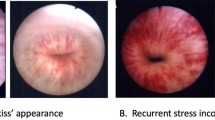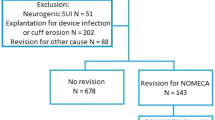Abstract
Purpose of Review
Repeat anti-incontinence surgery presents a challenging clinical entity due to altered anatomy and potentially impaired tissue health due to previous dissection, radiation, or infection. This document seeks to explore the etiologies leading to recurrent incontinence after primary intervention, outline a systematic approach to the evaluation of such patients, and explore our approach to the management of the most common scenarios.
Recent Findings
For patients with a prior artificial urinary sphincter (AUS), repeat surgery may be required due to atrophy, mechanical malfunction, or infection/erosion. We use a transcorporal technique for added tissue bulk in the setting of revision for urethral atrophy, a technique which was found to have significantly lower revision and cuff erosion rates while preserving erectile function. Recent studies demonstrate that both cuff downsizing and repositioning are associated with incontinence failure and downsizing has an additional statistically significant risk of mechanical failure. New strategies seeking to avoid such surgical revisions pursue urethral capsulotomy to restore urethral caliber.
Summary
In the case of atrophy and mechanical malfunction, complete device exchange is typically performed if the initial implantation was performed within 3 years. When erosion is encountered, explantation of all components is performed, with consideration for a delayed reimplantation which can be technically challenging. In patients with persistent or recurrent urinary incontinence after male urethral sling placement, limited data is available. From the series available, AUS placement after a sling provides excellent outcomes.








Similar content being viewed by others
References
Papers of particular interest, published recently, have been highlighted as: • Of importance
Van der Aa F, et al. The artificial urinary sphincter after a quarter of a century: a critical systematic review of its use in male non-neurogenic incontinence. Eur Urol. 2013;63(4):681–9.
Trost L, Elliott DS. Male stress urinary incontinence: a review of surgical treatment options and outcomes. Adv Urol. 2012;2012:287489.
• Linder BJ, et al. Long-term outcomes following artificial urinary sphincter placement: an analysis of 1082 cases at Mayo Clinic. Urology. 2015;86(3):602–7. Demosntrated AUS Secondary surgery-free survival of 90% at 1 year, 74% at 5 years, 57% at 10 years, and 41% at 15 years.
Gormley EA, et al. Diagnosis and treatment of overactive bladder (non-neurogenic) in adults: AUA/SUFU guideline amendment. J Urol. 2015;193(5):1572–80.
Petrou SP, Williams HJ, Young PR. Radiographic imaging of the artificial urinary sphincter pressure regulating balloon. J Urol. 2001;165(5):1773–5.
Brucker BM, et al. Artificial urinary sphincter revision: the role of ultrasound. Urology. 2013;82(6):1424–8.
Wang R, et al. Long-term outcomes after primary failures of artificial urinary sphincter implantation. Urology. 2012;79(4):922–8.
Lai HH, et al. 13 years of experience with artificial urinary sphincter implantation at Baylor College of Medicine. J Urol. 2007;177(3):1021–5.
Jura, Y.H. and C.V. Comiter, Urodynamics for postprostatectomy incontinence: when are they helpful and how do we use them? Urol Clin North Am, 2014. 41(3): p. 419-27, viii.
Bauer RM, et al. Impact of the ‘repositioning test’ on postoperative outcome of retroluminar transobturator male sling implantation. Urol Int. 2013;90(3):334–8.
Linder BJ, de Cogain M, Elliott DS. Long-term device outcomes of artificial urinary sphincter reimplantation following prior explantation for erosion or infection. J Urol. 2014;191(3):734–8.
Tuygun C, et al. Comparison of outcomes for adjustable bulbourethral male sling and artificial urinary sphincter after previous artificial urinary sphincter erosion. Urology. 2009;73(6):1363–7.
Christine B, Knoll LD. Treatment of recurrent urinary incontinence after artificial urinary sphincter placement using the AdVance male sling. Urology. 2010;76(6):1321–4.
Tuygun C, et al. Significance of fibrosis around and/or at external urinary sphincter on pelvic magnetic resonance imaging in patients with postprostatectomy incontinence. Urology. 2006;68(6):1308–12.
Raj GV, et al. Outcomes following revisions and secondary implantation of the artificial urinary sphincter. J Urol. 2005;173(4):1242–5.
• Linder BJ, et al. Artificial urinary sphincter mechanical failures-is it better to replace the entire device or just the malfunctioning component? J Urol. 2016;195(5):1523–8. No cutoff in time to mechanical failure could be identified to guide decision making in the management of mechanical artificial urinary sphincter failure.
Chung E, Cartmill R. Diagnostic challenges in the evaluation of persistent or recurrent urinary incontinence after artificial urinary sphincter (AUS) implantation in patients after prostatectomy. BJU Int. 2013;112(Suppl 2):32–5.
Webster GD, Sherman ND. Management of male incontinence following artificial urinary sphincter failure. Curr Opin Urol. 2005;15(6):386–90.
Andrews JR, et al. Artificial urinary sphincter revision with Quick Connects(®) versus suture-tie connectors: does technique make a difference? Turk J Urol. 2019;45(4):284–8.
Lai HH, Boone TB. Complex artificial urinary sphincter revision and reimplantation cases--how do they fare compared to virgin cases? J Urol. 2012;187(3):951–5.
• Sopko NA, W.E. Causes of artificial urinary sphincter failure and strategies for surgical revision: implications of device component survival. Eur Urol Focus. 2019. Balloon malfunction most commonly caused AUS failure. Consequently, initial interrogation of the PRB may avoid a second incision and urethral exposure for many patients requiring AUS revision.
Saffarian A, et al. Urethral atrophy after artificial urinary sphincter placement: is cuff downsizing effective? J Urol. 2003;169(2):567–9.
Hudak SJ, Morey AF. Impact of 3.5 cm artificial urinary sphincter cuff on primary and revision surgery for male stress urinary incontinence. J Urol. 2011;186(5):1962–6.
Simhan J, et al. 3.5 cm artificial urinary sphincter cuff erosion occurs predominantly in irradiated patients. J Urol. 2015;193(2):593–7.
Ziegelmann MJ, et al. Risk factors for subsequent urethral atrophy in patients undergoing artificial urinary sphincter placement. Turk J Urol. 2019;45(2):124–8.
Guralnick ML, et al. Transcorporal artificial urinary sphincter cuff placement in cases requiring revision for erosion and urethral atrophy. J Urol. 2002;167(5):2075–8 discussion 2079.
• Redmond E, et al. Improved artificial urinary sphincter outcomes using a transcorporal cuff placement in patients with a "fragile urethra". Can Urol Assoc J. 2020;14(12):E621–e624. Transcorporal cuff placement in patients with a "fragile urethra" is associated with lower revision and erosion rates compared to standard cuff placement.
Brito CG, et al. Use of a double cuff AMS800 urinary sphincter for severe stress incontinence. J Urol. 1993;149(2):283–5.
Magera JS Jr, Elliott DS. Tandem transcorporal artificial urinary sphincter cuff salvage technique: surgical description and results. J Urol. 2007;177(3):1015–9 discussion 1019-20.
Linder BJ, et al. Artificial urinary sphincter revision for urethral atrophy: Comparing single cuff downsizing and tandem cuff placement. Int Braz J Urol. 2017;43(2):264–70.
O’Connor RC, et al. Long-term follow-up of single versus double cuff artificial urinary sphincter insertion for the treatment of severe postprostatectomy stress urinary incontinence. Urology. 2008;71(1):90–3.
Kowalczyk JJ, Spicer DL, Mulcahy JJ. Erosion rate of the double cuff AMS800 artificial urinary sphincter: long-term followup. J Urol. 1996;156(4):1300–1.
• Eswara JR, et al. Revision techniques after artificial urinary sphincter failure in men: results from a multicenter study. Urology. 2015;86(1):176–80. Tandem cuff placement is associated with a lower rate of recurrent or persistent incontinence compared to repositioning.
Trost L, Elliott D. Small intestinal submucosa urethral wrap at the time of artificial urinary sphincter placement as a salvage treatment option for patients with persistent/recurrent incontinence following multiple prior sphincter failures and erosions. Urology. 2012;79(4):933–8.
Rahman NU, et al. Combined external urethral bulking and artificial urinary sphincter for urethral atrophy and stress urinary incontinence. BJU Int. 2005;95(6):824–6.
Bugeja S, et al. Urethral atrophy after implantation of an artificial urinary sphincter: fact or fiction? BJU Int. 2016;117(4):669–76.
• Terlecki, R.P. and S.K. Wilson, A new paradigm for surgical revision of the artificial urinary sphincter for recurrent stress urinary incontinence: Wilson’s Workshop 11. Int J Impot Res, 2020. Capsulotomy seeks to restore urethral caliber previously attributed to tissue atrophy while preserving existing urethral integrity without repositioning or cuff downsizing.
Montague DK, Angermeier KW. Artificial urinary sphincter troubleshooting. Urology. 2001;58(5):779–82.
Agarwal DK, Linder BJ, Elliott DS. Artificial urinary sphincter urethral erosions: temporal patterns, management, and incidence of preventable erosions. Indian J Urol. 2017;33(1):26–9.
Magera JS Jr, Elliott DS. Artificial urinary sphincter infection: causative organisms in a contemporary series. J Urol. 2008;180(6):2475–8.
Kowalczyk JJ, Nelson R, Mulcahy JJ. Successful reinsertion of the artificial urinary sphincter after removal for erosion or infection. Urology. 1996;48(6):906–8.
Flynn BJ, Webster GD. Evaluation and surgical management of intrinsic sphincter deficiency after radical prostatectomy. Rev Urol. 2004;6(4):180–6.
Rozanski AT, et al. Immediate urethral repair during explantation prevents stricture formation after artificial urinary sphincter cuff erosion. J Urol. 2014;192(2):442–6.
Bryan DE, Mulcahy JJ, Simmons GR. Salvage procedure for infected noneroded artificial urinary sphincters. J Urol. 2002;168(6):2464–6.
Wiedemann L, et al. Transcorporal artificial urinary sphincter implantation as a salvage surgical procedure for challenging cases of male stress urinary incontinence: surgical technique and functional outcomes in a contemporary series. BJU Int. 2013;112(8):1163–8.
Frank I, Elliott DS, Barrett DM. Success of de novo reimplantation of the artificial genitourinary sphincter. J Urol. 2000;163(6):1702–3.
Raj GV, Peterson AC, Webster GD. Outcomes following erosions of the artificial urinary sphincter. J Urol. 2006;175(6):2186–90 discussion 2190.
Elliott DS, et al. Does nocturnal deactivation of the artificial urinary sphincter lessen the risk of urethral atrophy? Urology. 2001;57(6):1051–4.
Kumar A, et al. Artificial urinary sphincter versus male sling for post-prostatectomy incontinence--what do patients choose? J Urol. 2009;181(3):1231–5.
Lentz AC, Peterson AC, Webster GD. Outcomes following artificial sphincter implantation after prior unsuccessful male sling. J Urol. 2012;187(6):2149–53.
Fisher MB, et al. Efficacy of artificial urinary sphincter implantation after failed bone-anchored male sling for postprostatectomy incontinence. Urology. 2007;70(5):942–4.
Abdou A, et al. Salvage therapy with artificial urinary sphincter after Advance™ male sling failure for post-prostatectomy incontinence: a first clinical experience. Prog Urol. 2012;22(11):650–6.
Ziegelmann MJ, et al. The impact of prior urethral sling on artificial urinary sphincter outcomes. Can Urol Assoc J. 2016;10(11-12):405–9.
Soljanik I, et al. Repeat retrourethral transobturator sling in the management of recurrent postprostatectomy stress urinary incontinence after failed first male sling. Eur Urol. 2010;58(5):767–72.
Author information
Authors and Affiliations
Corresponding author
Ethics declarations
Conflict of Interest
The authors declare no competing interests.
Human and Animal Rights and Informed Consent
This article does not contain any studies with human or animal subjects performed by any of the authors
Additional information
Publisher’s Note
Springer Nature remains neutral with regard to jurisdictional claims in published maps and institutional affiliations.
This article is part of the Topical collection on Voiding Dysfunction Evaluation
Rights and permissions
About this article
Cite this article
Lipworth, R., Linder, B.J. & Elliott, D.S. Reoperative Anti-incontinence Surgery. Curr Bladder Dysfunct Rep 17, 20–29 (2022). https://doi.org/10.1007/s11884-021-00642-3
Accepted:
Published:
Issue Date:
DOI: https://doi.org/10.1007/s11884-021-00642-3




